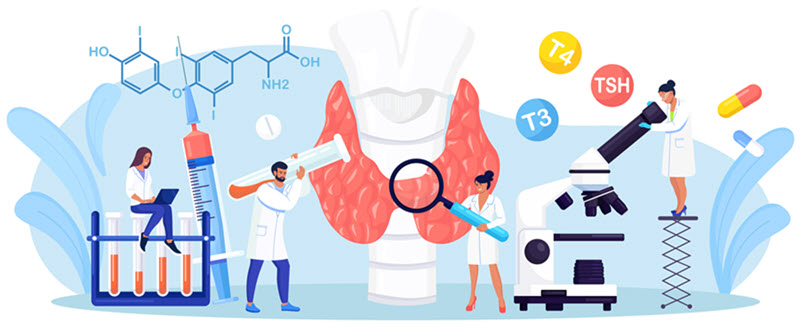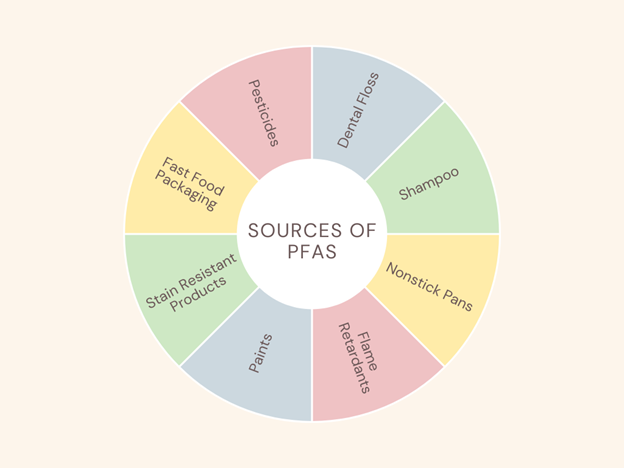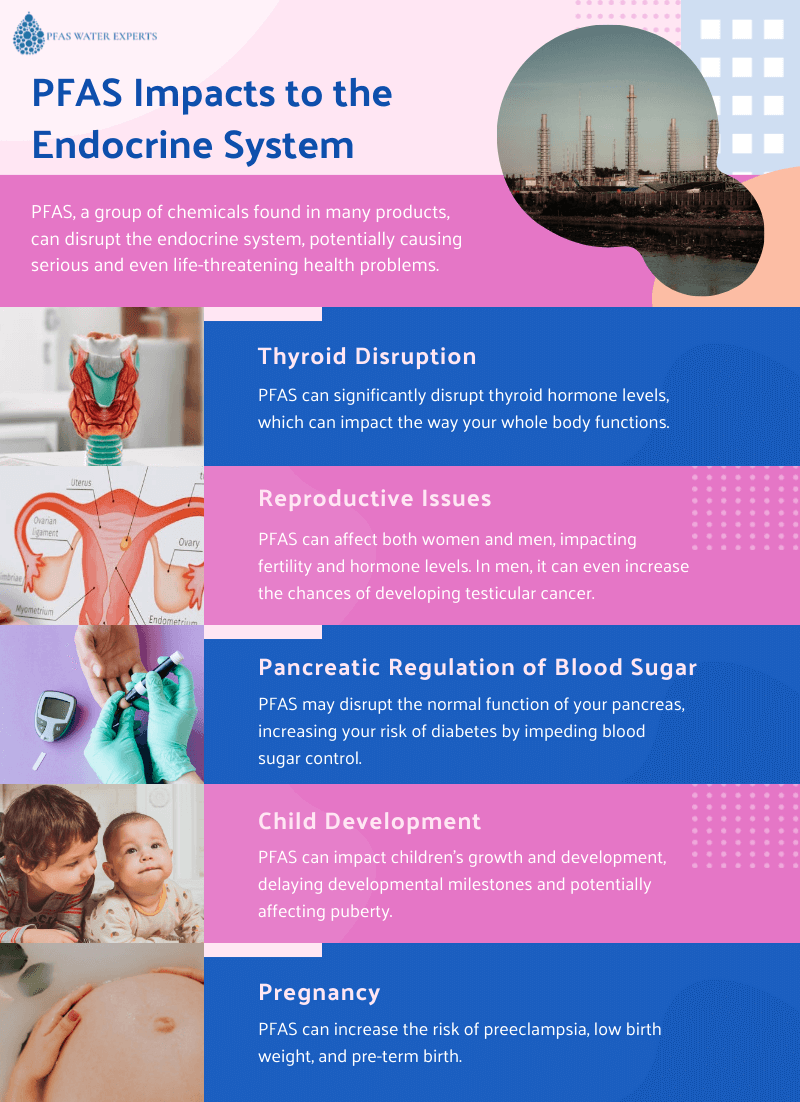Introduction
While scientific innovation has solved a great number of problems humanity faces, sometimes innovation comes with unintended consequences. The phenomenon of per- and polyfluoroalkyl substances (PFAS) is one such example.
These manmade chemicals are also known as “forever chemicals” because they have been observed to be extraordinarily resistant to degradation in the environment. That’s because PFAS are compounds characterized by carbon-fluorine bonds, one of the strongest bonds in chemistry.
Another problem is that PFAS are used extensively in consumer and commercial products- from water-resistant fabrics to building materials. PFAS are used in paints to for a glossy finish and to repel stains. PFAS give nonstick pans their smooth and slick surface. These are just a few examples, as PFAS have many applications.
So, if we are stuck with PFAS- a question naturally arises: how do PFAS impact our bodies and the environment?
How PFAS Enter the Body
There are a myriad of ways PFAS infiltrate the body.
- Ingestion by mouth: PFAS are water-soluble, meaning they readily enter drinking water.
- Transdermal absorption: Personal care products that contact the skin contain PFAS, such as cosmetics or moisturizers, provide a transdermal route for PFAS to enter the bloodstream. While transdermal absorption appears to be limited, some scientific studies have shown that PFAS are capable of some amount of absorption through the skin.
- Inhalation: Additionally, PFAS can be inhaled. One example of how PFAS can be inhaled through dust due to its ability to settle into dust particles.
Once inside the body, the disrupt the normal functions of the endocrine system in multiple ways.
How PFAS Impact the Endocrine System
PFAS have been coined as Endocrine Disrupting Compounds (EDCs) along with other chemicals such as BPA, phthalates, and dioxins because they significantly disrupt the normal functioning of the endocrine system of both men and women.
The endocrine system includes the reproductive system, pituitary, thyroid, adrenal glands, pancreas, and more. Since the endocrine system also orchestrates growth and human development, PFAS’s role in child development has also become of heightened concern and has drawn the attention of scientific researchers.
Here’s how various parts of the endocrine system are impacted by PFAS:

The thyroid is a butterfly-shaped gland located at the base of the throat in men and women. The thyroid gland controls metabolism, in addition to many other roles in the body.
PFAS have been shown to dysregulate TSH, an important brain hormone that regulates thyroid hormone release. Every organ system of the body contains thyroid hormone receptors, which is a testament to how vital thyroid hormones are. This is why deficiency of thyroid hormone negatively impacts every organ system of the body.
Thyroid Cancer Rates are Rising
In the United States, the incidence of thyroid cancer tripled from 1974 to 2013. While this may be in part due to improvements in technology for detecting thyroid cancer, it is unclear what proportion of the increased incidence of thyroid cancer over the past decades can be attributed to technological advancements.
In 2023, Mount Sinai researchers discovered a link between PFAS and thyroid cancer. While thyroid cancer has a high survival rate, it can require surgical removal of the thyroid. After surgical removal of the thyroid, one becomes dependent on thyroid medication for life.

PFAS Effects in Adult Females
A study of 950 women from two preconception care clinics in Shanghai, China found that higher levels of serum PFAS was correlated to an increased incidence in self-reported irregular cycles. Irregular menstrual cycles are correlated to more difficulty for couples attempting to conceive.
Research has shown that women exposed to PFAS can undergo earlier menopause, possibly due to increased oxidative stress on the ovaries that accelerates ovarian aging. Earlier menopause is by no means inconsequential- in fact earlier menopause is associated with higher risk of cardiovascular disease.
PFAS Effects in Adult Males
Men are not exempt from the deleterious effect of PFAS on the reproductive system. High levels of PFAS in men appear to lower testosterone levels. Testosterone is important for healthy metabolism, muscle mass, and libido in men. Additionally, testosterone fuels healthy sperm production. In fact, a 2020 systematic review linked high PFAS exposure to weaker semen parameters in men.
One of the most significant epidemiological studies conducted called the C8 Health Project identified a significant link between high PFOA (a type of PFAS) levels in the blood or low concentrations of chronic exposure increased rates of testicular cancer.

Glycemic control is key for preventing prediabetes and diabetes. Diabetes can have serious consequences including impaired wound healing, retinal damage, nerve damage, kidney disease, and much more.
PFAS exposure disrupts the normal function of the pancreas and has been linked to elevated fasting glucose levels. Higher fasting glucose levels increase the risk of prediabetes and diabetes.

Human development is an important process of physiologic maturing. Humans evolve from infants to adolescents. With the onset of puberty, adolescents gradually mature into adults.
Disruptions in the orchestra of hormones that control human development can delay important milestones, such as reaching intellectual or reproductive maturity.
PFAS Effects in Infants
A 2022 study of infants with an older sibling with autism showed that prenatal exposure to PFAS was inversely associated with cognitive scores.
High PFAS levels in children have been associated with delays in pubertal milestones.
PFAS Effects in Girls
For girls, a 2025 study found that higher PFAS levels have been shown to impact development in three ways:
- Causes lower than normal estrogen levels
- Later age of the first menstrual period
- Delays physical signs of puberty
PFAS Effects in Boys
In boys, in utero exposure to PFAS has been associated with decreased testicular volume.
A 2016 study observed children living near to an industrial plant with high PFAS contamination in the local drinking water. This study found the higher the PFAS concentration in young boys, the lower their testosterone levels.
Testosterone is the key male sex hormone responsible for the development of the male reproductive system. Additionally, testosterone is responsible for masculinizing characteristics in men such as muscle mass, body hair, and the thickening of the vocal chords responsible for a deep voice.

PFAS have been linked to higher-risk pregnancies, including increasing risk of gestational diabetes and preeclampsia. Gestational diabetes increases risk of high birth weight babies that require medical intervention to be delivered, such as an induction or cesarean section.
Preeclampsia, which is known as an issue of high blood pressure during a pregnancy, is associated with preterm births. Preterm infants have higher risk of breathing, feeding, vision, and hearing problems.
Additionally, PFAS have been linked to lower birth weights in a 2022 meta-analysis of 21 studies. Lower birth weights in infants are linked to developmental delays, learning and behavioral issues, and chronic diseases such as heart disease or diabetes later in life.
Protecting Your Endocrine System from PFAS
Filter Your Water with a Certified PFAS Water Filter
The EPA has taken the guesswork out of finding a science-backed method for reducing PFAS in your body. Water filters that are certified under NSF/ANSI 53 or 58 standards for PFAS elimination ensure that independent testing supports the filter for PFAS elimination.
Some examples of water filters that meet these standards include:
- AquaTru Reverse Osmosis System
- Clearly Filtered Water Pitcher
- Aquasana OptimH2O Reverse Osmosis System + Claryum
- ProOne Big + Multi-stage Filtration System
For more information on if your local water municipality is affected by high levels of PFAS, visit the Environmental Working Group’s interactive webpage for PFAS water contamination in the United States. The EPA’s PFAS water contamination map even lists the specific PFAS your water municipality has tested.
Limit Exposures
A simple solution to lowering PFAS is to reduce your use of high-PFAS containing items such as nonstick pans, fast food packaging, and pesticide-containing food.
The market is responding to the demand for safe products free from PFAS. Whether it be PFAS-free paints or shampoos, the good news is that there are many options for finding the products you need that are free of PFAS.
The Environmental Working Group’s Skin Deep Database contains reports of over 6,000 personal care product brands. If you are wondering if your personal care products contain PFAS that may be negatively impacting your health, simply look up your common products using the database.
PFAS are commonly in stain-repellent treatments on carpets, furniture, and upholstery. Opting out of these treatments if possible is one way to protect yourself from PFAS in the home.
PFAS are also in stain-repellent mattress covers. Flame retardants within mattresses are also high in PFAS. Fortunately, there is a significant market for non-toxic mattresses and bedding. In fact, natural materials such as wool and latex act as flame retardants and are commonly used in the non-toxic mattress market.
Conclusion
Awareness is growing regarding the negative impacts of PFAS, and any steps towards reducing PFAS exposure can reduce risk of a multitude of hormonal problems for this generation and the next.
Safeguarding your endocrine system from the deleterious effects of PFAS starts with becoming a conscious consumer. Building habits that circumvent PFAS and electing for clean products in your home are the best ways to reduce PFAS in your body. Over time, these collections of small habits become second nature.
Take a stand for your wellness by being mindful of PFAS and join the growing community of people protecting their bodies from toxic, forever chemicals.
Written By:

Dr. Laurel Ash
Medical Contributor
Dr. Ash is a medical author and reviewer at PFAS Water Experts. As a Washington and Oregon board-certified Naturopathic physician, her clinical focus is in understanding of how environmental factors influence hormonal health.








